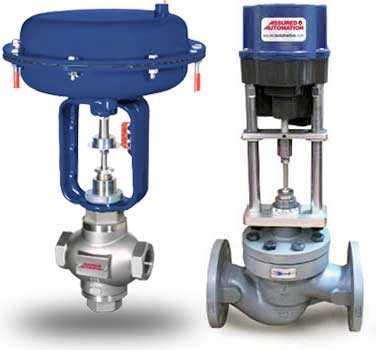Picking the Right Control Valves: A Guide to Optimal System Efficiency
Picking the Right Control Valves: A Guide to Optimal System Efficiency
Blog Article

Maximize Energy Financial Savings and Convenience With Advanced Building Automation Controls
In the realm of modern-day architecture and facility monitoring, the combination of sophisticated structure automation controls stands as a critical innovation. The merging of technology and sustainability has birthed a new period where energy efficiency, convenience optimization, and operational streamlining are no more achievable truths yet far-off desires. By utilizing the power of automation, structures can adapt, respond, and progress in ways that were as soon as unbelievable. The capacity for substantial energy financial savings and improved convenience is not just an opportunity yet an assurance waiting to be fulfilled. This paradigm change in building monitoring holds the key to opening a globe where environmental conscientiousness and occupant health harmoniously exist together within the walls of our frameworks.
Power Efficiency Perks
Power effectiveness benefits can substantially decrease power consumption and functional prices in structures. Energy-efficient systems, such as sophisticated building automation controls, can enhance the use of sources like illumination, air conditioning, and heating, leading to reduced power expenses over time.
Moreover, boosted power efficiency can lengthen the life-span of building devices and systems. By operating extra effectively, HVAC systems, lighting fixtures, and other building components experience much less deterioration, leading to lowered maintenance and replacement prices. Additionally, energy-efficient buildings commonly regulate higher residential property worths and rental rates, supplying long-term monetary advantages to owners.
In addition, energy performance can enhance occupant convenience and performance. Effectively controlled indoor atmospheres with optimum lights and thermal conditions create a more conducive and pleasurable work area, resulting in enhanced employee complete satisfaction and performance. Generally, the energy performance benefits related to advanced building automation controls are multifaceted, incorporating cost savings, environmental stewardship, and resident well-being.
Boosted Convenience Control
Enhancing comfort control in structure atmospheres requires an innovative combination of innovative automation systems for ideal passenger health. By utilizing advanced building automation controls, centers can tailor the interior environment to fulfill the details needs and choices of owners. control valves.
By incorporating these advanced controls, structures can not just boost convenience but likewise boost power effectiveness by enhancing system procedures based on real occupancy and use patterns. Ultimately, focusing on resident convenience via innovative automation systems leads to an extra pleasurable and healthier indoor atmosphere.
Operational Efficiency Improvements

Furthermore, the application of real-time tracking and analytics tools makes it possible for building drivers to recognize power inadequacies and functional abnormalities quickly. By constantly keeping track of power usage patterns and system efficiency metrics, adjustments can be made in real-time to optimize energy intake and make sure peak operational performance. control valves. Furthermore, incorporating need reaction techniques into building automation controls can even more improve operational effectiveness by dynamically adjusting power use based upon grid problems and prices signals
Indoor Climate Optimization
Reliable interior climate optimization is a basic facet of building automation controls, making sure residents' convenience and wellness while making the most of power savings. By using advanced sensors and controls, building automation systems can continuously change and check temperature level, moisture degrees, air top quality, and ventilation to create an optimal indoor environment. Preserving consistent and comfy conditions not only improves owner fulfillment but additionally improves productivity and general wellness.
Interior climate optimization likewise plays a critical role in power performance. By fine-tuning air conditioning, ventilation, and heating systems based on real-time data and tenancy patterns, building automation controls can significantly reduce power consumption - control valves. As an example, executing approaches such as demand-controlled ventilation and thermal zoning can help lessen power waste while ensuring that each area of the structure obtains the essential conditioning.

Sustainable Atmosphere Development
Structure automation regulates not only optimize indoor environment problems for power performance and passenger comfort yet additionally lay the foundation for developing a sustainable atmosphere with tactical administration of systems and resources. By incorporating innovative building automation modern technologies, such as sensing units, actuators, and smart software application, centers can monitor and readjust power use in real-time to reduce waste and lower their carbon impact. These systems enable anticipating maintenance, determining prospective concerns prior to they intensify and maximizing equipment performance to enhance durability and efficiency.
Furthermore, sustainable atmosphere production extends beyond power administration to encompass water preservation, waste reduction, and interior air quality renovation. Building automation controls can regulate water use, detect leaks, and ensure correct garbage disposal techniques, adding to total sustainability efforts. In addition, by controlling and keeping an eye on ventilation and filtering systems, these modern technologies enhance resident health and performance while lowering power usage connected with cooling and heating procedures.
Conclusion
Finally, progressed building automation manages offer substantial benefits in regards to power financial savings, he has a good point comfort control, operational efficiency, interior climate optimization, and developing a lasting atmosphere. By executing these controls, structures can achieve optimum performance while lowering power usage and improving occupant convenience. It appears that the use of sophisticated automation technology is essential in boosting building performance and developing a much more sustainable future.
Energy efficiency benefits can substantially minimize power consumption and functional costs in structures. Generally, the power efficiency benefits associated with innovative structure automation controls are multifaceted, incorporating expense savings, ecological stewardship, and resident health.
Additionally, integrating demand action techniques right into structure automation controls can even my website more improve functional effectiveness by dynamically adjusting energy usage based on grid problems and pricing signals.
Structure automation manages not only maximize interior climate problems for power effectiveness and occupant comfort yet also lay the structure for creating a sustainable setting with calculated management of resources and systems.In conclusion, progressed building automation controls deal substantial advantages in terms of power cost savings, comfort control, operational effectiveness, indoor environment optimization, and developing a sustainable atmosphere.
Report this page